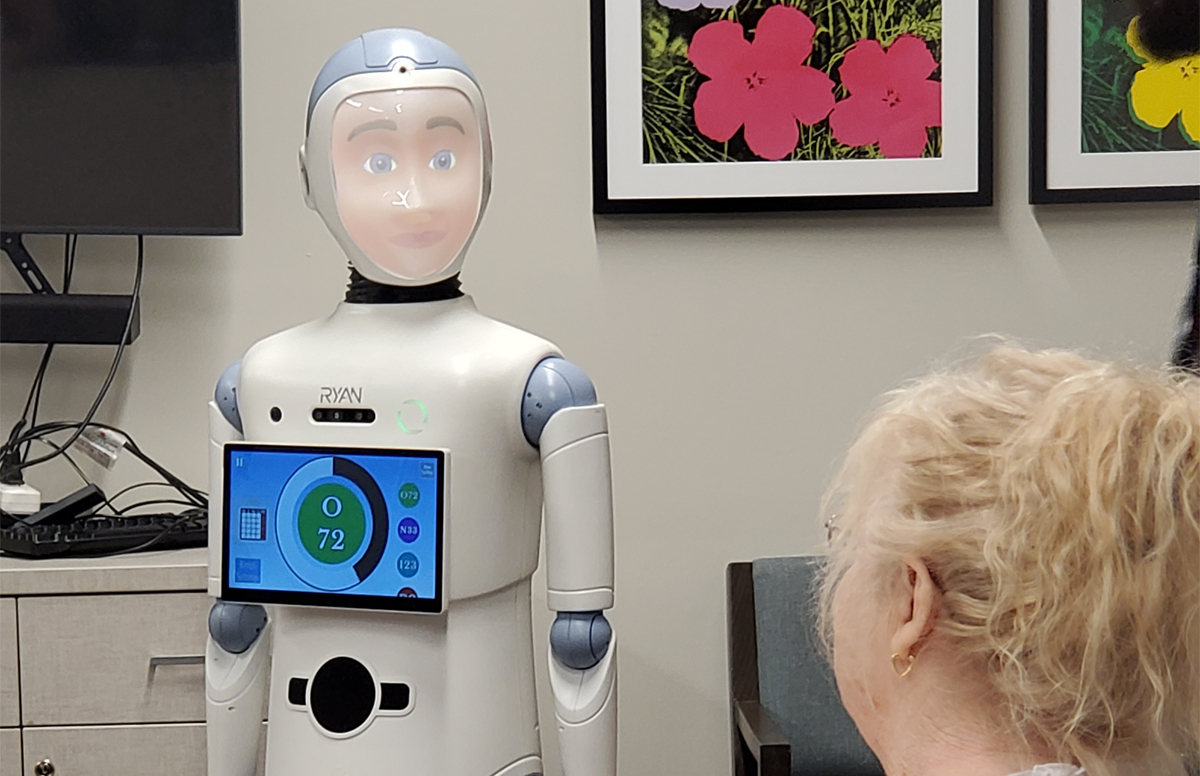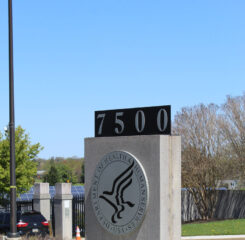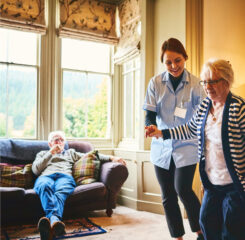Some senior living organizations are not content simply to purchase new technologies for their residents: they are helping to inform the design of assistive tools. By partnering with universities to pilot robots and other innovative technologies, LeadingAge and CAST members are helping to inform technology development, ensuring that future products truly meet older adults’ unique needs.
In addition, these partnerships are bringing residents and staff a sense of purpose, giving students invaluable learnings, and surfacing essential design insights for cutting-edge research hubs.
Leaders from LeadingAge members Baptist Senior Family and Eaton Senior Communities, and LeadingAge CAST Patrons RiverSpring Living and RiverWoods, have graciously shared their advice on how to initiate and make the most of technology research partnerships.
Partnerships That Break New Ground
Aging services providers can partner on technology studies in many ways, as these examples demonstrate.
Baptist Senior Family Residents Shape Development of Assistive Robots
A partnership that won the 2025 Innovation of the Year award from LeadingAge PA is a leader in testing new assistive technologies. Baptist Senior Family, based in Pittsburgh, PA, collaborates with Carnegie Mellon University’s Robotic Caregiving and Human Interaction Lab (CMU) on multiple innovative research projects.
The study “VoicePilot: Harnessing LLMs as Speech Interfaces for Physically Assistive Robots,” funded by the National Institutes of Health, was the first to involve human subjects—Baptist Senior Family residents—interacting directly with a large language model (LLM) speech interface integrated into an assistive robot. The Obi robot assists people who can no longer feed themselves. Residents offered invaluable input on the effectiveness of Obi’s listening and learning algorithmic functions.
For the “ChatGPT for Assistive Robotics” study, Baptist Senior Family’s personal care and memory support residents offered input to students developing an assistance robot that expresses facial emotions and interacts with older adults. In another joint study with CMU, residents, including those living with mild dementia or Alzheimer’s disease, contributed to developing an assistive cooking system for older adults.
Eaton Senior Communities Pilots Companion Robot
Residents are also helping with robotics research at Eaton Senior Communities. The affordable housing community in Lakewood, CO, is a pilot site for companion robot Ryan, in partnership with Dr. Mohammad Mahoor, professor of electrical and computer engineering at the University of Denver, along with his spin-off development company, DreamFace Technologies.
The collaboration began in 2014, when Eaton responded to a request for senior living providers to participate in Ryan’s development. Now, Eaton’s director of wellness initiatives, Sarah Schoeder, connects with Mahoor each month, with residents sharing feedback on new iterations of Ryan—playing games with the robot, giving feedback on Ryan’s conversation abilities, and the like. At the robot’s visit in July, said Schoeder, Ryan (shown at right) led Bingo, Name that Tune and Twenty Questions. “We had so much fun—and Ryan now speaks Spanish and French!”
RiverSpring Living Tests AI Companion
In another technology pilot designed to alleviate social isolation, residents at RiverSpring Living in Riverdale, NY, help test the artificial intelligence (AI) companion Meela, which initiates phone calls to engage older adults.
A recent Wall Street Journal article shared the experiences of residents who talk baseball with Meela, read plays to her, and reminisce about good times. RiverSpring Living has collaborated on a clinical trial to study Meela’s effectiveness, and its residents will participate in an upcoming third-party Institutional Review Board ethics evaluation.
RiverWoods Pilots Robot and Photo Sharing Project
A partnership between RiverWoods, with three communities in New Hampshire, and the University of New Hampshire (UNH) enabled occupational therapy students to pilot a robot for wellness checks and socialization during the pandemic. Currently, team members and residents are testing another innovation: “Gram-Mail,” developed by a 2025 UNH graduate, offers a way to upload photos and have them delivered via mail to grandparents or other loved ones.
Benefits for Partners and Residents
LeadingAge and CAST members see many benefits in these partnerships, from creating tested and effective technologies to bringing meaning to residents and staff.
When opening its newest community in 2019, RiverWoods prioritized reaching out to its local university. “Many of our residents are scholars, and their love of education, teaching, and lifelong learning extends to their work in research projects or curriculum activities,” said Kim Gaskell, vice president of operations for RiverWoods, who led the partnership’s creation. Taking part in studies allows residents to give back and students to “ask questions, try out their thinking or research, and get helpful feedback from a group of older adults who have a lot of lived experience,” said Gaskell, recipient of the 2025 LeadingAge Leadership Award.
For the resident volunteers at Baptist Senior Family, participating in technology studies “mitigates some of the reticence about artificial intelligence, robotics, and other technologies,” said Dr. Z. Allen Abbott, VP of philanthropy at the Baptist Homes Foundation. He also added that staff are “pleased to be directly involved with these ventures, maintaining the human touch with our residents.”
Baptist Senior Family is so committed to advancing senior care that the organization is developing a research and wellness center on its historic campus in Pittsburgh. There, it will incorporate research with technology and educational partners into wellness programming—and share the resulting data with partners to bring new technologies that benefit all older adults.
RiverSpring Living’s experience with Meela supports this approach. “The more we explore and learn about advancements, the better for our residents, and also the broader long-term care community,” said Chief Information Officer David Finkelstein. “Clinical trials and research to advance the body of knowledge in the [long-term and post-acute care] space benefit everyone in our field.”
Best Practices for Starting Research Partnerships
For aging services providers that wish to build these collaborations, first steps are to tap relationships inside and outside of the organization, find partners and funding, and plan for success.
- Involve the community. “The best way to begin … is to have a staff and resident population who possess curiosity and a desire to make a difference for others,” said Abbott. Gaskell recommends asking residents how they want to be involved; RiverWoods is now forming a resident advisory board to help navigate resident participation.
- Identify research partners and funding. Once the community is on board, reach out to schools’ research institutes. Build connections with faculty members and department chairs around topics of interest, advises CMU Robotics Institute professor Dr. Zackory Erickson, as they have students who need projects and are often looking for ideas.
Bring in philanthropic resources, too. Philanthropy can play a major role in identifying potential partners and funders, especially with future federal funding for research being in jeopardy, said Abbott. Having a strong, well-connected, and proactive foundation or philanthropy department staff is important, he said.
- Perform due diligence first, then commit. Before accepting research partnerships, create benchmarks to evaluate opportunities and build internal systems that enable studies to run smoothly. “It is essential to carefully vet the vendor sponsoring the research to ensure the technology is robust and novel, and the company has the funding to follow through with the research study,” said Finkelstein. “We also recommend creating a project team to ensure internal resources are aligned with the goals of the research, and the commitment to follow through with the project requirements.”
Gaskell noted that different university departments may reach out to various staff members, and establishing a structure and process to understand potential partnerships is important. Internships take the most thought; organizations need a staff member who is willing to teach, learn, and provide both exposure and feedback.
Before the study gets underway, designate a single point of contact to manage the project—a staff liaison is “imperative,” noted Diana Delgado, president and CEO, Eaton Senior Communities—and create a collaborative interdisciplinary team to carry out the research. Then get ready to engage your residents and staff in designing innovations that help them and all older adults.

 Shutdown Week Three: Impact of Ongoing Closure on Affordable Housing
Shutdown Week Three: Impact of Ongoing Closure on Affordable Housing CMS Debuts Models: ACCESS, ELEVATE and LEAD
CMS Debuts Models: ACCESS, ELEVATE and LEAD


